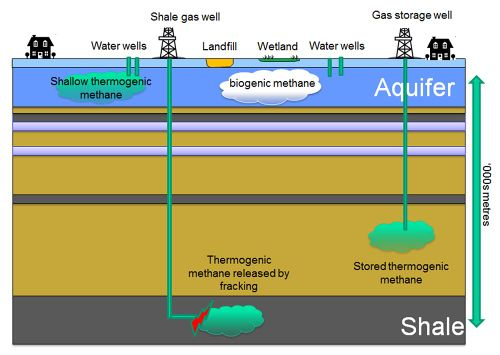OR/15/071 Methane and GB groundwater
| Bell, R A, Manamsa, W G K, and Dochartaigh, B É Ó. 2015. The baseline concentrations of methane in Great British groundwater - the National Methane Baseline survey. British Geological Survey Internal Report, OR/15/071. |
Methane and associated risks
Dissolved methane when ingested has no known human health impacts and there is therefore no water quality standard for methane in the UK or internationally. Except under pressures exceeding hydrostatic due to in-situ production or leakage from underlying formations (unlikely in most water supply aquifers), methane is present exclusively in the dissolved phase until water is pumped to the surface. If methane concentrations exceed the equilibrium solubility at ambient pressure (approximately 0.05µg/l under the open atmosphere), methane will de-gas from the water until the system re-equilibrates. This de-gassing may create a potential explosion hazard or asphyxiation risk if it occurs in a confined space, and therefore constitutes the main risk of methane to human health. Methane in confined spaces has caused problems in mines, tunnels and landfills, resulting in the establishment of standards for the potential explosive limits of methane in air. More information on this and the calculation of the potential hazard for water degassing in confined spaces is provided in Hooker and Bannon (1993[1]).
Sources of methane in groundwater
Methane in groundwater is derived from two main sources; biogenic methane, which is bacterially produced and thermogenic methane, which is formed during thermal decomposition of organic matter (Figure 2).

Biogenic methane is mainly associated with shallow anaerobic groundwater environments, such as peat bogs, wetlands, lake sediments and landfills, although it is detectable in nearly all groundwater. Prior to the work by Darling and Gooddy (2006)[2], dissolved methane in the UK was widely considered only likely to be found in groundwaters that were sufficiently reducing, limiting occurrences to zones in confined aquifers with dissolved oxygen concentrations <0.1 mg/l. Instead, methane was found to be ubiquitous throughout the aquifers studied: Chalk, Lower Greensand, Lincolnshire Limestone and Sherwood Sandstone. The source of this biogenic methane derives from two alternative mechanisms; acetate fermentation and carbon dioxide reduction. In groundwater environments it is likely that acetate fermentation is the dominant process for methane formation (Darling and Gooddy, 2006[2]).
Thermogenic methane, formed during thermal decomposition of organic matter (kerogen) at depth, is usually associated with coal, oil and gas fields and is not typically found in shallow groundwater environments. Thermogenic methane is generally present at depth in the sub-surface, stored in conventional gas reservoirs; these conventional reservoirs are created when hydrocarbons migrate from a source rock (organic rich shales or mudstones) into a formation with suitable porosity and permeability characteristics that make extraction possible, e.g. Permo-Triassic sandstones or Permian limestones. Unconventional exploration is where the source rock for this thermogenic methane is directly targeted, but these shales or mudstones tend to have much lower permeability. This low permeability is why hydraulic fracturing is required to extract the gas from these tight formations.
Gas ratio (C1/C2+) and stable isotope analysis (δ13C and δ2H) of dissolved gases can be used to identify the potential origin of methane (thermogenic or biogenic), although isotope ratios can also be affected by in-situ oxidation. In general, biogenic methane tends towards lighter δ13C and δ2H, due to the preferential usage of 12C by microbial communities. The presence of C2+ hydrocarbons (lower gas ratio), is more indicative of a thermogenic methane source, as these hydrocarbons are typically associated with oil and gas reservoirs. As aerobic methane oxidation by methanotrophs can alter these ratios to leave residual methane with a more thermogenic signature, isotopic identification methods should not be done in isolation.
In the UK most methane in groundwater is likely to be biogenic in origin, although thermogenic contributions may be locally important where gases have migrated from depth or there is slow release from previously deeply buried, low permeability, organic-rich rocks. The lower explosive limit (LEL) for methane in air is 5% by volume; the lowest dissolved methane concentration that theoretically could give rise to a 5% mixture in a confined space is 1,600µg/l. This concentration will therefore be used in this report as a level, above which there is the potential for explosive conditions, given a confined space and total methane degassing at the surface. The concentration of methane required for isotopic investigation into the potential source is >1,000µg/l.